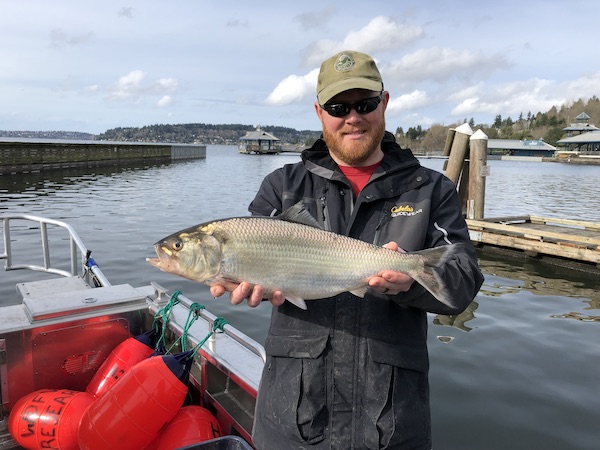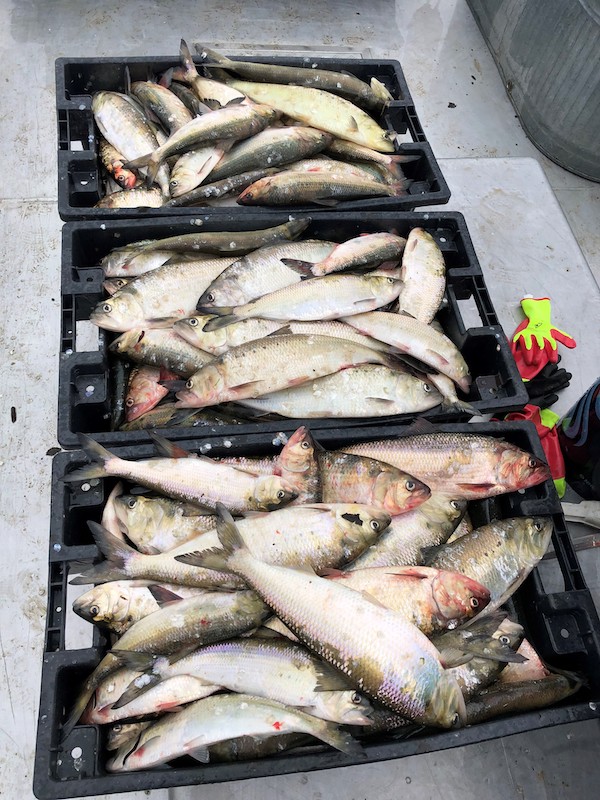
Here’s Lake Washington’s Next Damn Headache
American shad appear to have made themselves at home, their numbers are suddenly booming and they feed on the same stuff as young salmon do.
Concerns and questions should be growing over the burgeoning American shad population in Lake Washington, where as of mid-April crews had netted a minimum of at least six times as many of the fish as last year.
What’s more, some genetic evidence suggests that unlike the shad that run up the Columbia, Willamette and Umpqua Rivers each spring, the Seattle strain may mostly never leave the lake, spawning and rearing in the system instead, a very rare behavior for the East Coast fish brought to the West Coast in the late 1800s and one that theoretically multiplies their impact and makes control more difficult on the 34-square-mile body of water.

It’s worrisome because while shad don’t prey on salmon smolts, it’s believed they can compete for forage with young Chinook, coho and sockeye, further complicating efforts to boost returns of these far more coveted native Northwest fish.
Ironically, the growth of the lake’s shad population was essentially only discovered because of ongoing tribal and state research around how to reduce smolt predation by nonnative perch and bass, as well as native trout and northern pikeminnows. The loudest alarms in recent years have blared over illegally introduced walleye and northern pike – guilty as charged – which, to be sure, are problematic if their numbers grow.
But catches of those fish have also been low compared to the sudden spike in shad – all of 29 fish in 2015, 2017 and 2018 combined, then 108 in 2021, 215 in 2022 and, so far at least this year, 1,200 by the Washington Department of Fish and Wildlife alone.
The Muckleshoot Indian Tribe and fisheries biologist Eric Warner are heading up the effort to track shad abundance and are actively netting too. Last June, in comments relayed to this magazine by the National Marine Fisheries Service, Warner pointed to catches of .02 shad per night in the 2010s which grew to .18 in 2021 and .35 in 2022, and warned, “If this trend continues it has the potential to dramatically reshape the Lake Washington ecosystem.”
A local guide reported state crews were catching north of 200 shad a day this year.
YOU COULD PERHAPS shrug off last decade’s 29 shad as strays from the Columbia or elsewhere that have also turned up in Puget Sound midwater trawls in the past. But now it’s becoming clearer that somehow a stay-at-home shad population has established itself in Lake Washington, and it appears to be widespread in the 22-mile-long, mile-and-a-half-wide water.
“This winter (February-March) we have encountered what I would consider large numbers of shad in the lake. We sampled multiple areas of the lake this winter and shad abundances were high in all areas of the lake we sampled – north end, middle and south end,” said WDFW district fisheries biologist Aaron Bosworth.
It frustrates the efforts of Frank Urabeck, the lake’s longtime sockeye booster and angler advocate.
“Always something new working against return of Lake Washington sockeye fisheries,” he lamented last month.
Urabeck, now in his mid-80s, is bulldogging what might be a last-ditch effort to bring back the famous fishery he and tens of thousands of other anglers last enjoyed in 2006. In recent years, biologists have found that collecting adult sockeye at the Ballard Locks and bypassing the often too warm and disease-friendly waters of the Lake Washington Ship Canal markedly improves survival rates, which should help increase egg production. Another, wider slate of experiments is planned this year.
Urabeck was also behind a $700,000 proviso in the just-passed state operating budget that will provide funding for a “demonstration project” to suppress predator fish populations in the watershed. The goal of it all is to figure out if it’s feasible to expect a sockeye fishery by 2032.
This year’s higher shad catch could, of course, just be a function of more concerted and better targeted efforts by Muckleshoot and WDFW biologists to understand Lake Washington’s piscivorous fish populations, a preamble to doing something about reducing salmon smolt losses at migratory chokepoints. In 2019, yellow perch and rock bass – another fast-growing nonnative population – were found to be doing “way more damage” than smallmouth or largemouth, at least at select spots in the ship canal. But it also highlights the maddening Whac-A-Mole complexity of this highly altered metro water.

SHAD ARE PLANKTIVORES – they forage on zooplankton, copepods and insect larva – which means they are competing for the same food as young salmon. Most hatchery Chinook and coho smolts – the vast bulk of the basin’s total production for the two species – move through the system fairly rapidly in spring, feeding as they go, but sockeye stick around a year to rear in the lake. Shad and salmon have similar water temperature needs, but shad can also utilize shallower, warmer, more forage-rich sections of the water column, giving them a competitive edge.
A growing abundance of shad in Lake Washington theoretically could provide a predation buffer for salmon, but only for a narrow window in time because of how they grow – thicker around the middle – rendering them relatively safe at a young age. They’re also known to be higher in thiamine, which can cause issues for fish that eat too many of them.
And sexually maturing at three to seven years of age means they consume zooplankton for that many years as well. That lengthy stay at the lunch counter also impacts other organisms in the lake like longfin smelt, which in turn are prey for native rainbow and cutthroat trout, northern pikeminnow and – in another bizarro Lake Washington mystery – kokanee. Kokanee are landlocked sockeye that also feed on zooplankton, but a guide reported that the bellies of kokes she and clients caught in late winter and again in April were stuffed with smelt.
(Back in 2009, when I did a story about Wallowa Lake’s ginormous kokanee, a guide told me he occasionally found 2- to 5-inch kokes, as well as sucker minnows, in the stomachs of larger ones.)
THE PORTENTS ARE perplexing, but what about the glass-half-full proposition of a potential new shad fishery at the masses’ doorstep? At this point it’s unclear what form that might take. If most shad are spending their entire lives in the lake, like an admittedly small sample of otoliths appears to show, that essentially rules out the most popular and productive ways to catch them – casting or anchor fishing from the bank or a boat as they make their upstream spawning run.
But we anglers are a notoriously adaptive bunch and there is a troll fishery practiced in Florida at the extreme south end of their East Coast range. “For some reason, in the St. Johns, they hit best in the middle of the day … They’ll hit a shad dart on a trolling fly line,” writes John McPhee in The Founding Fish.

Who is to know the future, but at this point, given the Muckleshoots’, WDFW’s and state legislature’s interest in boosting survival of Lake Washington salmon, the impetus will be to do something about this before it gets out of hand, like ongoing hammer-down efforts to control northern pike in the Upper Columbia and Lake Roosevelt. Shad are more than willing to multiply. After 150 years of running up the Columbia, in 2023 they comprised 78 percent of all adult salmonids and lampreys counted at Bonneville, with millions more presumed to never venture past the dam.
In 2021, a science board recommended that a whole lot more research is needed to understand shad impacts in the Columbia, and they also reported that an entirely new life history is being seen there – “mini-shad,” which spend a year or two in the river while the rest of their year-class go to sea.
Who knows how a shad population that mostly resides in a lake may differ, but I wonder if we’re not seeing evolution in action? If so, it could be a very unsettling development for native Northwest stocks like Lake Washington’s Chinook, coho and sockeye.
